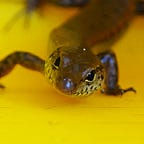Change of Season
Homalathus brings all the birds to the yard
As we move from Wet to Dry, new birds arrive. Sulphur-crested Cockatoos fly over in flocks with wingbeats that scintillate against the blue sky. Cattle Egrets perch on the back of the big Brangus steer or stalk around the goats until the goats have enough and chase them off. Black Kites patrol the fields, gliding on the lightest thermals rising from the land. Australian King Parrots, bright green and red, turn up in small flocks, announcing their presence with metallic whistles.
Birds are dropping by to pick a few berries from the Bleeding Heart Trees (Homalanthus) while the going is still good. The usual suspects — Brown Cuckoo-doves, Australasian Figbirds and Hornbill Friarbirds — are regular visitors. Pied Currawongs arrive late afternoon to the outrage of Lewin’s Honeyeaters, who are ineffectual in driving away the bigger birds. Sometimes their piercing shrieks of irritation alert the bulkier and more organised Blue-faced Honeyeaters, who do not put up with the berry-stealing, egg-eating, chick-murdering Pied Currawongs. The currawongs consume a few more Bleeding Heart fruit before leaving. But leave they do. Blue-faced Honeyeaters always prevail.
